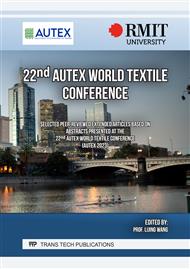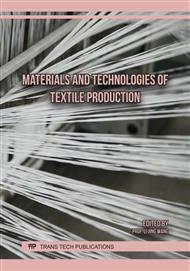[1]
Sauer, M., Schüppel. D. (2021). Composites Market Report. The Global Market for Carbon Fibers and Carbon Composites. https://composites-united.com/wp-content/uploads/2022/05/ CU-Marktbericht-2021_ENG_Kurz_final.pdf.
Google Scholar
[2]
Pickering, S.J., Turner, T.A., Warrior, N.A. (2006) Moulding compound development using recycled carbon fibres. SAMPE Fall Technical Conference. Dallas, USA.
Google Scholar
[3]
Hengstermann, M., Raithel, N., Abdkader, A., Hasan, M.M.B., Cherif, C. (2016). Development of new hybrid yarn construction from recycled carbon fibers for high performance composites. Part-I: basic processing of hybrid carbon fiber/polyamide 6 yarn spinning from virgin carbon fiber staple fibers. Textile Research Journal, 86(12), 1307-1317.
DOI: 10.1177/0040517515612363
Google Scholar
[4]
Hengstermann, M., Hasan, M.M.B., Abdkader, A., Cherif, C. (2016). Development of a new hybrid yarn construction from recycled carbon fibers (rCF) for high-performance composites. Part-II: Influence of yarn parameters on tensile properties of composites. Textile Research Journal, 87(13), 1655–1664.
DOI: 10.1177/0040517516658511
Google Scholar
[5]
Akonda, M.H., Lawrence, C.A., Weager, B.M. (2012). Recycled carbon fibre-reinforced polypropylene thermoplastic composites. Composites Part A: Applied Science and Manufacturing, 43, 79–86.
DOI: 10.1016/j.compositesa.2011.09.014
Google Scholar
[6]
Akonda, M.H., EL-Dessouky, H.M., Lawrence, C.A. et al. (2014). A novel non-crimped thermoplastic fabric prepreg from waste carbon and polyester fibres. Journal of Composite Materials, 48, 843–851.
DOI: 10.1177/0021998313478992
Google Scholar
[7]
Goergen, C., Baz, S., Mitschang, P., et al. (2017). Recycled Carbon Fibers in Complex Structural Parts - Organic Sheets Made of rCF Staple Fiber Yarns. KEM, 742, 602–609.
DOI: 10.4028/www.scientific.net/kem.742.602
Google Scholar
[8]
Baz, S., Goergen, C. (2016). Innovative textile structures made out of recycled carbon fibers. Aachen-Dresden-Denkendorf International textile Conference, Dresden.
Google Scholar
[9]
Goergen, C., Schommer, D., Duhovic, M., et al. (2020). Deep drawing of organic sheets made of hybrid recycled carbon and thermoplastic polyamide 6 staple fiber yarns. Journal of Thermoplastic Composite Materials, 33, 754–778.
DOI: 10.1177/0892705718811407
Google Scholar
[10]
Hasan, M. M. B., Nitsche, S., Abdkader, A., et al. (2018). Carbon fibre reinforced thermoplastic composites developed from innovative hybrid yarn structures consisting of staple carbon fibres and polyamide 6 fibres. Composites Science and Technology, 167, 379–387.
DOI: 10.1016/j.compscitech.2018.08.030
Google Scholar
[11]
Hasan, M. M. B., Nitsche, S., Abdkader, A., et al. (2019).Influence of Process Parameters on the Tensile Properties of DREF-3000 Friction Spun Hybrid Yarns Consisting of Waste Staple Carbon Fibre for Thermoplastic Compo-sites. Textile Research Journal, 89 (1), 32-42.
DOI: 10.1177/0040517517736472
Google Scholar
[12]
Abdkader, A., Khurshid, M.F., Hasan, M.M.B., et al. (2023). Recent develop-ments in yarn formation technology for producing innovative hybrid yarn structures from staple carbon and thermoplastic fibers for high-performance composites. Journal of Composite Materials, 002199832311544.
DOI: 10.1177/00219983231154481
Google Scholar
[13]
Hengstermann, M., Kopelmann, K., Nocke, A., Abdkader, A., Cherif, C (2020). Development of a new hybrid yarn construction from recycled carbon fibres for high-performance composites: Part IV: Measurement of recycled carbon fibre length. Journal of Engineered Fibers and Fabrics (15), 1558925020910729.
DOI: 10.1177/1558925020910729
Google Scholar
[14]
Salhotra, K.R., Chattopadhyay, R., Dhamija, S., et al. (2002). Twist structure of friction-spun yarns: Part I-Open-end DREF-II yarns. Indian Journal of Fibre and Textile Research, 0975-1025.
DOI: 10.1080/00405000208630560
Google Scholar
[15]
Konda, F., Okamura, M., Merati, A.A. (1996). Effect of suction air pressure in friction spinning on yarn properties. Textile Research Journal, 66(7), 446-52.
DOI: 10.1177/004051759606600705
Google Scholar



